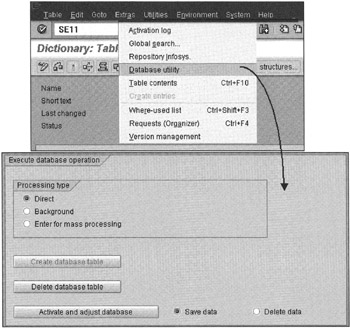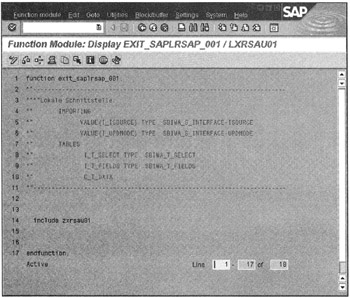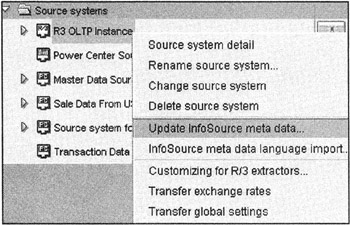Extending Transaction Data Content
Before deciding on extending business content, extensively analyze present business content, such as the InfoSources. When you find that needed data is missing, you should enhance your transaction InfoSources. This is because the enhancements you make will be made in the SAP R/3 OLTP environment. For this reason, you need to stay involved with SAP R/3 OLTP development plans to include BW-specific development efforts in the SAP R/3 OLTP project life cycle. Often, your OLTP configuration may not be capturing the needed data. This can burden existing OLTP configuration projects.
The transaction data enhancement consists of the following steps:
-
Define a project using IMG, as shown in Figure 13-2. When you right-click Customizing for R/3 extractors, you directly log on to the source SAP R/3 instance.

Figure 13-2: Enhancing Data Extractors in SAP R/3. -
Edit the InfoSource structure to append new data elements using transaction program RSAO0007. If you do not know which structure to update, look at table ROIS-STRUCTURE for transaction data extracts. Use transaction SE16 or SE17 to list the InfoSource and respective structure.
Note Any time you change a structure, you must activate and adjust the database. Use transaction SE11 and open the transfer structure. Under the Utilities menu option, select Database utility. Click the Edit button. Then select the Save data radio button and click the Activate and adjust database button, as shown in Figure 13-3. Go back in SE11 and reactivate the structure.

Figure 13-3: Activating and Adjusting the Database after Appending a Structure Definition.Note You cannot have the same data element multiple times in a structure definition. Create a new data element using transaction SE11, and then use that new element in the structure. Moreover, you cannot have time elements, such as UZEIT, in the structures for InfoSources.
-
Assign InfoObjects to the additional fields using program RSAO0001 in SAP R/3 OLTP.
-
Add new InfoObjects in the SAP R/3 instance. You may create new InfoObjects that may or may not be master data dependent or independent.
-
Maintain the Enhancement component and add code to fill the new data elements in the structure. To do so, you need to open the project using IMG or transaction CMOD; select enhancement RSAO0001, and select EXIT_SAPLRSAP_001, as shown in Figure 13-4.

Figure 13-4: Adding Custom ABAP Code to Fill New Data Elements in the InfoStructure using EXIT_SAPLRSAP_001. -
Write code to populate new fields. The EXIT_SAPLRSAP_001 function module shows a template ready for you to write ABAP code to fill new data elements. Like any function module, it has Import and Export parameters.
The Import parameter I_ISOURCE is the name of the InfoSource, and parameter I_UPDMODE is the transfer mode as requested by the SAP BW Scheduler, such as IDOC or tRFC with ODS.
Exporting table parameter I_T_SELECT is selection criteria set during the SAP BW data request, I_T_FIELDS contains a list of the transfer structure fields, and parameter C_T_DATA is a table containing data records received from the SAP BW data extraction API in the form of the source system, as defined in the table ROIS in the SAP R/3 OLTP.
-
Add actual code to populate new fields. To do so, double-click include zxrsau01, as shown in Figure 13-4.
-
Add code to fill new fields in the InfoStructure.
-
After saving the code, you must activate the project before your enhancement can be used.
-
On the SAP BW side, upload this enhanced InfoStructure, as shown in Figure 13-5.

Figure 13-5: Updating Metadata for Enhanced InfoObjects From SAP R/3 OLTP in SAP BW. It is Suggested that You Enhance Business Content on the OLTP Side, and then Pull Metadata in SAP BW.
| Team-Fly |
EAN: 2147483647
Pages: 174